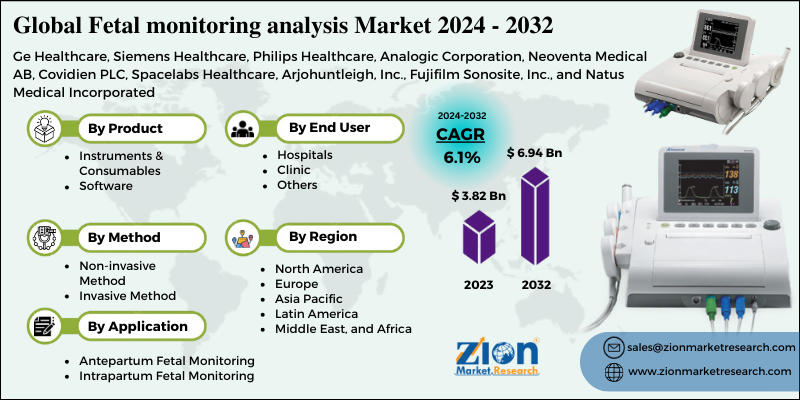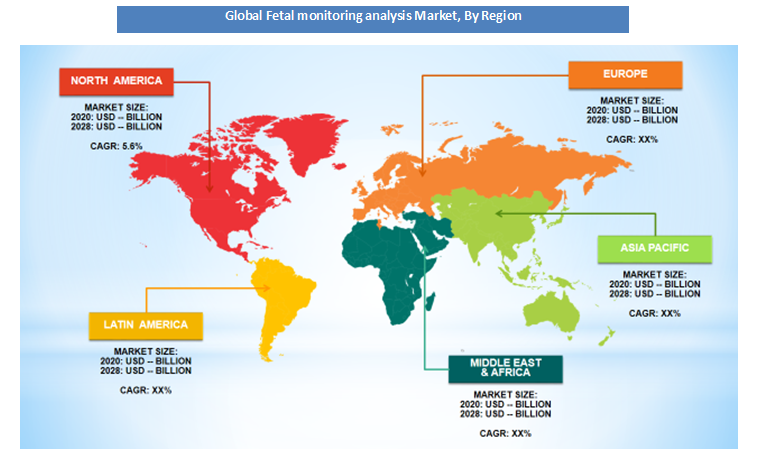Fetal Monitoring Analysis Market Size, Share, And Growth Report 2032

Fetal monitoring analysis Market By Product (Instruments & Consumables, and Software), Application (Antepartum Fetal Monitoring, and Intrapartum Fetal Monitoring,), By Method (Non-invasive Method, and Invasive Method), By End-User (Hospitals Clinic, and Others): Global Industry Perspective, Comprehensive Analysis and Forecast, 2024 - 2032-
| Market Size in 2023 | Market Forecast in 2032 | CAGR (in %) | Base Year |
|---|---|---|---|
| USD 3.82 Billion | USD 6.94 Billion | 6.1% | 2023 |
Fetal monitoring analysis Market Size
According to Zion Market Research, the global Fetal monitoring analysis Market was worth USD 3.82 Billion in 2023. The market is forecast to reach USD 6.94 Billion by 2032, growing at a compound annual growth rate (CAGR) of 6.1% during the forecast period 2024-2032.
The report offers a comprehensive analysis of the market, highlighting the factors that will determine growth, potential challenges, and opportunities that could emerge in the Fetal monitoring analysis Market industry over the next decade.
Global Fetal Monitoring Analysis Market Overview
Fetal monitoring are the instruments used to record the heartbeat of the fetus. The method depends on the ob-gyn and hospital policies, also depend on the risk of problems. The instruments are used to analyze and monitor the chronic lung diseases, mental retardation, neonatal diseases, hypothermia, vision & hearing problems, and jaundice.
COVID-19 Impact Analysis:
Fetal monitors play an important role in prenatal and maternal care by reducing mortality rate during childbirth. Fetal monitoring is used to record the fetal vital physiological functions by using an instrument. Pre-term and premature births are necessitating the need for continuous fetal monitoring. In last few years, the rate of preterm births increased rapidly. In addition, increasing prevalence of cardiopulmonary diseases, technological advancement such as noninvasive surgeries, increasing multiple births due to rising success rate of in vitro fertilization (IVF) procedures are expected to increase the demand for fetal monitoring analysis in coming five years.
Fetal monitoring analysis market is expected to witness a significant growth in coming five years owing to rapid technological advancement in the healthcare industry, increasing incidences of cardiopulmonary diseases, increase in a number of post-term pregnancy, government and non-government initiatives for maternal & fetal health over the world. In addition, rising investments in the development of fetal monitors are also expected to boost this market in coming five years. However, the high cost of equipment and prevalence of low birth rates in certain developed countries are expected to hamper the growth of this market. In spite of these restraints, emerging economies can be an opportunity for fetal monitoring analysis market.
Fetal Monitoring Analysis Market: Growth Factors
Major boosting factors for fetal monitoring analysis market are increasing non-government and government initiatives for fetal & maternal health all over the world, as per the analysts at Zion Market Research. In addition to this, rising awareness of manufacturers and willingness of players to spend in the development of fetal monitoring is also powering the development of fetal monitoring analysis market. Moreover, enhanced models that assist to calculate the maternal parameters such as maternal heart rate, and blood pressure are also likely to fuel the development of fetal monitoring analysis market in coming years. On the other hand, lack of intervening guidelines and technological challenges might hamper the development of the global fetal monitoring analysis market in the years to come.
Fetal Monitoring Analysis Market: Segmentation
On the basis of product, fetal monitoring analysis market is categorized into instruments & consumables and software. Instruments & consumables are further subdivided into ultrasound & ultrasonography, electronic fetal monitoring, fetal electrodes, fetal Doppler, uterine contraction monitor, telemetry solutions, accessories & consumables. In the product segment, instrument and consumables attributed for the largest share of the market and are expected to dominate this segment in coming five years. Ultrasound fetal doppler held more than 60% share of the market in 2016. A defect in birthrate and favorable government organizations initiatives to improve parental care are the major driving factors for the demand of instruments and consumables in coming five years.
Based on application, the fetal monitoring analysis market is divided into antepartum and intrapartum. The antepartum application has accounted for the largest share in application segment of fetal monitoring analysis market owing to increasing prevalence of congenital anomalies within the forecast period and expected to witness the fastest growth with a CAGR of more than 2.9% in coming five years. For example, congenital heart defects CHDs affect nearly about 40,000 births per year in the United States. The prevalence (the number of babies born with heart defect compared to the total number of births) of some CHDs, especially mild types, is increasing. The most common type of heart defect is a ventricular septal defect (VSD).
On the basis of the method, fetal monitoring analysis market is categorized into non-invasive and invasive methods. The non-invasive methods gained the largest share of this market in 2016. Growth in this segment is expected to fuel by increasing government and non-government initiatives to prevent maternal mortality worldwide. On the basis of portability, the fetal monitoring analysis market is divided into portable systems and non-portable systems. An end-user segment of fetal monitoring analysis market includes; hospitals, clinics, and others.
On the basis of end user, hospital segment hold the majority of fetal monitoring market share 2019, owing to strong presence of hospitals across the globe, and owing to enhanced fetal monitoring devices provided by hospitals and availability of skilled physicians and infrastructure.
Fetal monitoring analysis Market: Report Scope
| Report Attributes | Report Details |
|---|---|
| Report Name | Fetal monitoring analysis Market |
| Market Size in 2023 | USD 3.82 Billion |
| Market Forecast in 2032 | USD 6.94 Billion |
| Growth Rate | CAGR of 6.1% |
| Number of Pages | 110 |
| Key Companies Covered | Ge Healthcare, Siemens Healthcare, Philips Healthcare, Analogic Corporation, Neoventa Medical AB, Covidien PLC, Spacelabs Healthcare, Arjohuntleigh, Inc., Fujifilm Sonosite, Inc., and Natus Medical Incorporated among others |
| Segments Covered | By Product, By Application, By Method, By End-User and By Region |
| Regions Covered | North America, Europe, Asia Pacific (APAC), Latin America, Middle East, and Africa (MEA) |
| Base Year | 2023 |
| Historical Year | 2018 to 2022 |
| Forecast Year | 2024 - 2032 |
| Customization Scope | Avail customized purchase options to meet your exact research needs. Request For Customization |
Fetal Monitoring Analysis Market: Regional Analysis
North America dominated this market by accounting for 41.5% in 2016 and is expected to grow at a high CAGR in coming five years. U.S. holds the largest market share in fetal monitoring analysis market in this region. Major driving factors include rising population, increasing prevalence of birth defects and preterm births. For instance, in the U.S. 3,000 pregnancies are affected by neural tube defects every year. Birth defects are the leading cause of infant deaths, accounting for 20% of all infant deaths.
Europe is expected to gain the second largest position in this market within the forecast period due to rising government initiatives for enhancing healthcare in coming five years. In Asia Pacific, a major share of this market is expected to contribute by China, India, and Japan due to favorable government initiative towards the development of healthcare infrastructure. Latin America and the Middle East and South Africa are expected to witness a healthy market growth within the forecast period.
Key Market Players & Competitive Landscape
Some of key players in Fetal monitoring analysis Market are:
- Ge Healthcare
- Siemens Healthcare
- Philips Healthcare
- Analogic Corporation
- Neoventa Medical AB
- Covidien PLC
- Spacelabs Healthcare
- Arjohuntleigh Inc.
- Fujifilm Sonosite Inc.
- Natus Medical Incorporated
The global Fetal monitoring analysis Market is segmented as follows:
By Product
- Instruments & Consumables
- Ultrasound & ultrasonography
- Electronic fetal monitoring
- Fetal electrodes
- Fetal doppler
- Uterine contraction monitor
- Telemetry solutions
- Accessories & consumables
- Software
By Application
- Antepartum Fetal Monitoring
- Intrapartum Fetal Monitoring
By Method
- Non-invasive Method
- Invasive Method
By End-User
- Hospitals
- Clinic
- Others
By Region
- North America
- The U.S.
- Canada
- Europe
- France
- The UK
- Spain
- Germany
- Italy
- Rest of Europe
- Asia Pacific
- China
- Japan
- India
- South Korea
- Southeast Asia
- Rest of Asia Pacific
- Latin America
- Brazil
- Mexico
- Rest of Latin America
- Middle East & Africa
- GCC
- South Africa
- Rest of Middle East & Africa
Table Of Content
Methodology
FrequentlyAsked Questions
Fetal monitoring analysis involves assessing the health and well-being of a fetus during pregnancy and labor using devices that track heart rate, movement, and uterine contractions. It helps detect potential complications and ensures timely medical interventions for safe delivery.
According to study, the Fetal Monitoring Analysis Market size was worth around USD 3.82 billion in 2023 and is predicted to grow to around USD 6.94 billion by 2032.
The CAGR value of Fetal Monitoring Analysis Market is expected to be around 6.1% during 2024-2032.
North America has been leading the Fetal Monitoring Analysis Market and is anticipated to continue on the dominant position in the years to come.
The Fetal Monitoring Analysis Market is led by players like Ge Healthcare, Siemens Healthcare, Philips Healthcare, Analogic Corporation, Neoventa Medical AB, Covidien PLC, Spacelabs Healthcare, Arjohuntleigh, Inc., Fujifilm Sonosite, Inc., and Natus Medical Incorporated among others.
Choose License Type
List of Contents
Market SizeGlobal Fetal Monitoring Analysis Market Overview COVID-19 Impact Analysis:Fetal Monitoring Analysis Growth FactorsFetal Monitoring Analysis SegmentationReport ScopeFetal Monitoring Analysis Regional AnalysisKey Market Players Competitive LandscapeThe global Market is segmented as follows: By RegionRelatedNews
HappyClients
Zion Market Research
Tel: +1 (302) 444-0166
USA/Canada Toll Free No.+1 (855) 465-4651
3rd Floor,
Mrunal Paradise, Opp Maharaja Hotel,
Pimple Gurav, Pune 411061,
Maharashtra, India
Phone No +91 7768 006 007, +91 7768 006 008
US OFFICE NO +1 (302) 444-0166
US/CAN TOLL FREE +1 (855) 465-4651
Email: sales@zionmarketresearch.com
We have secured system to process your transaction.
Our support available to help you 24 hours a day, five days a week.
Monday - Friday: 9AM - 6PM
Saturday - Sunday: Closed








